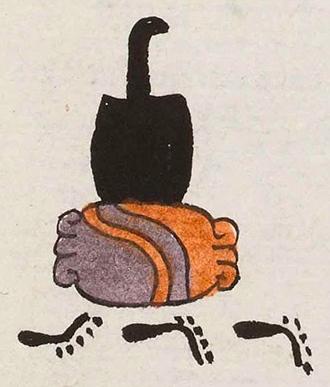Itzteyocan (Mdz48r)
The compound glyph for the place name Itzteyocan includes the following components: an obsidian blade (itztli), a stone (tetl), and a road (otli). The "o" of otli provides the phonetic clue to the presence of the nominal suffix of possesion of a certain quality (yotl), which otherwise would not appear visually. The locative suffix, -can, is not represented visually, either.
Stephanie Wood
The footprints represent the noun for road (otli), providing a phonetic value for the "yo" element, which refers to a place that has a "lot of" something or is "full of" something. This differs from the footprint on top of a hill, which more typically indicates the verb pano (to cross over), providing the phonetic value of the locative suffix -pan, such as can also be seen in the compound glyphs for Tlaltizapan, Ocpayocan, Xomeyocan, and Xocoyocan. [See Gordon Whittaker Deciphering Aztec Hieroglyphs, 2021, 100.]
Footprint glyphs have a wide range of translations. In this collection, so far, we can attest to yauh, xo, pano, -pan, paina, temo, nemi, quetza, otli, iyaquic hualiloti, huallauh, tetepotztoca, totoco, -tihui, and the vowel "o." Other research (Herrera et al, 2005, 64) points to additional terms, including: choloa, tlaloa, totoyoa, eco, aci, quiza, maxalihui, centlacxitl, and xocpalli.
Stephanie Wood
ytzteyocan. puo
Itzteyocan, pueblo
Stephanie Wood
c. 1541, but by 1553 at the latest
Stephanie Wood
stones, rocks, monoliths, piedras, rocas, monolitos, nombres de lugares

itz(tli), obsidian blade, https://nahuatl.wired-humanities.org/content/itztli
te(tl), stone or rock, https://nahuatl.wired-humanities.org/content/tetl
-yocan, place where there is a lot of (the preceding noun), https://nahuatl.wired-humanities.org/content/yocan
yo(tl), -yo(tl)-, having that characteristic or quality/inalienable possession, https://nahuatl.wired-humanities.org/content/yotl
o(tli), road, path, trail, https://nahuatl.wired-humanities.org/content/otli
-can (locative suffix), https://nahuatl.wired-humanities.org/content/can-2
Codex Mendoza, folio 48 recto, https://digital.bodleian.ox.ac.uk/objects/2fea788e-2aa2-4f08-b6d9-648c00..., image 106 of 188.
The Bodleian Libraries, University of Oxford, hold the original manuscript, the MS. Arch. Selden. A. 1. This image is published here under the UK Creative Commons, “Attribution-NonCommercial-ShareAlike 3.0 License” (CC-BY-NC-SA 3.0).







